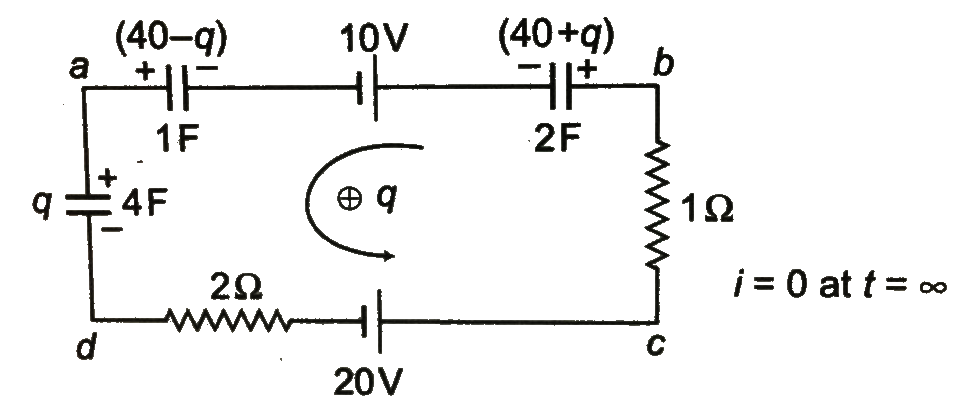A 10.0μF parallel-plate capacitor with circular plates is connected to a 12.0V battery.
(a) What is the charge on each plate?
(b) How much charge would be on the plates if their separation were doubled while the capacitor remained connected to the battery?
(c) How much charge would be on the plates if the capacitor were connected to the 12.0V batter Y after the radius of each plate was doubled without changing their separation?
The correct Answer is:C, D
a. q=CV
b. C=ε0Ad or C∝1d
if d is doubled, C will remain half. Hence q will also remain half.
c.q=CV=(ε0Ad)V=ε0(πR3)Vd
orq∝R2
R is doubled. Hence q will become four times or 480μC
Topper's Solved these Questions
- CAPACITORSBook:DC PANDEY ENGLISHChapter:CAPACITORSExercise:OBJECTIVE_TYPE
Explore 1 Video
- CAPACITORSBook:DC PANDEY ENGLISHChapter:CAPACITORSExercise:OBJECTIVE_TYPE
Explore 1 Video
- ATOMSBook:DC PANDEY ENGLISHChapter:ATOMSExercise:MEDICAL ENTRANCES GALLERY
Explore 42 Videos
- COMMUNICATION SYSTEMBook:DC PANDEY ENGLISHChapter:COMMUNICATION SYSTEMExercise:Subjective
Explore 11 Videos
Similar Questions
In the circuit shown as potential difference of 60V is appliled across AB. The potential difference between the points M and N is

View SolutionIn the circuit shown as potential difference of 60V is appliled across AB. The potential difference between the points M and N is

View SolutionGiven the value of Rydberg constant is 107m−1, the waves number of the last line of the Balmer series in hydrogen spectrum will be:
View SolutionThe LC product of a tuned amplifier circuit require to generate a carrier wave of 1 MHz for amplitude modulation is
View SolutionEach plate of a parallel plate capacitor has a charge q on it. The capacitor is now connected to a battery. Now,
View SolutionA 10.0μF parallel-plate capacitor with circular plates is connected to a 12.0V battery.
(a) What is the charge on each plate?
(b) How much charge would be on the plates if their separation were doubled while the capacitor remained connected to the battery?
(c) How much charge would be on the plates if the capacitor were connected to the 12.0V batter Y after the radius of each plate was doubled without changing their separation?
View SolutionA parallel plate capacitor is charged by connecting is plates to the terminals of a battery. The battery remains connected to the condenser plates and a glass plate is interposed between the plates of the capacitor, then
View SolutionA parallel plate capacitor with plates separated by air acquires 1μC of charge when connected to a battery of 500V. The plates still connected to the battery are then immersed in benzene [k=2.28]. Then a charge that flows from the battery is.
View SolutionA parallel plate capacitor has plate A and separation d between the plates. The capacitor is connected to a battery of emf V. (a) find the charge on the capacitor. (b) the plate separation is decreases to d/2. Find the extra charge given by the battery to the positive plate. (c) work done in reducing separation between plates.
View SolutionThe separation between the plates of a parallel plate capacitor is t, and the intervening space is filled with glass, of dielectric constant 6. Now, the separation between the plates is increased by t. How would the charge on the capacitor and the potential difference between its plates charge, if
The plates remain connected with the charging battery
View Solutionएक समांतर - प्लेट संधारित्र , किसी निश्चित विभव तक आवेशित किया जाता है। फिर आवेशन करने वाली बैटरी अलग कर दी जाती है। अब यदि संधारित्र की प्लेटें एक दूसरे से परे की जाएँ , तो
View Solutionएक समान्तर प्लेट संधारित्र की प्रत्येक प्लेट पर q आवेश है। अब संधारित्र बैटरी से जुड़ा है। निम्नलिखित में से कौन-सा कथन सत्य है?
View SolutionEach plate of a parallel plate capacitor has a charge q on it. The capacitor is now connected to a battery. Now,
View SolutionA parallel plate capacitor is charged by connecting it to a battery. The battery is disconnected and the plates of the capacitor are pulled apart to make the separation between the plates twice. Again the capacitor is connected to the battery (with same polarity) then
View SolutionA parallel plate capacitor has plate A and separation d between the plates. The capacitor is connected to a battery of emf V . (a) find the charge on the capacitor. (b) the plate separation is decreases to d//2 . Find the extra charge given by the battery to the positive plate. (c) work done in reducing separation between plates.
View Solution
